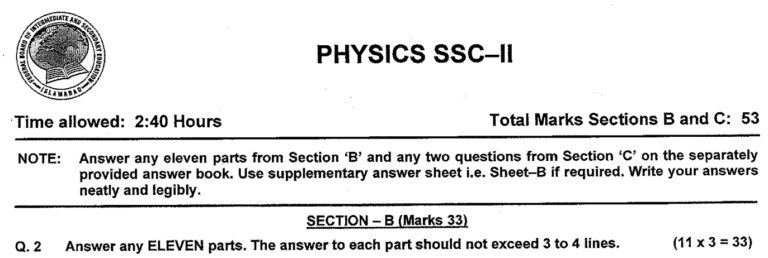Class 10 Computer Science Solved Past Paper 2019
Class 10 Computer Science Solved Past Paper 2019 is given below for helping the Federal Board students. For more class 10 solved past papers visit this page.
Class 10 Computer Science Solved Past Paper 2019 is given below for helping the Federal Board students. For more class 10 solved past papers visit this page.
Class 10 Physics 2021 Solved Paper Overseas Federal Board FBISE Class 10 Physics 2021 Solved Past Paper Overseas is solved for you in this post. For more Class 10 Solved Papers visit our Class 10 Solved Papers Page. Section A Q1. MCQs Class 10 Physics 2021 OverseasSection B Q2. (i) Furnish three examples of motion…
Federal Board FBISE Class 10 Pak Studies FBISE Past Paper 2022 is given below for you in this post. For more Class 10 Papers visit our Class 10 Past Papers Page. Class 10 Pak Studies Paper 2022 See also English 10 Model Paper 2020 Federal Board
Physics 10 Solved Paper 2017 Past papers always play a vital role in exam preparations. By consulting past papers, a student comes to know about the paper pattern of his forthcoming exam. We have produced the Federal Board Physics 10 Solved Paper 2017 in this post. You can see the more fbise solved past papers…

[et_pb_section][et_pb_row][et_pb_column type=”4_4″][et_pb_text] Class 10 Physics 2019 While preparing for any exam, past papers always play a very important role. By studying past papers, a student feels comfortable about his forthcoming exam. We have solved the Class 10 Physics 2019 Past Paper in this post. For more Class 10 Solved Past Paper visit Here. We are…
Federal Board, Class 10 Chemistry 2018 Past Papers Local is solved in this post. For more solved past papers visit our past papers page. Class 10 Chemistry 2018 Solved Paper Section A Q1. MCQs Class 10 Chemistry 2018 Solved Paper Section B Q2. (i) What are the conditions for equilibrium to be continued? Ans. …

Following is the Federal Board, Islamabad Urdu 10 FBISE Past Paper 2017, you can also see the solution of this paper very soon. Stay tuned to see the latest Past Papers on our website. Please Visit & Like our Facebook Page. See also Class 10 Computer Science Solved Model Paper 2020